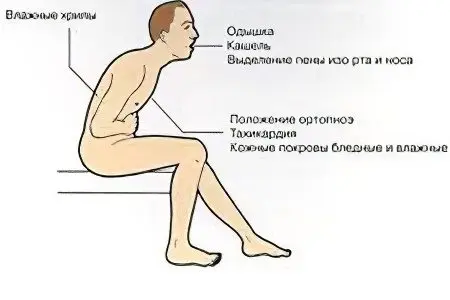Contents

Bronchial asthma is a fairly common modern respiratory disease. It manifests itself in the form of periodic attacks of shortness of breath, a strong cough, sometimes capable of developing into an attack of suffocation. The reason for this is the reaction of the respiratory tract to any irritant that has fallen into them. Because of this, the bronchi are greatly narrowed, while producing a large amount of mucus, which prevents the patient from breathing normally, making it difficult for air to enter the lungs.
There are various reasons why asthma attacks occur. Based on this, non-allergic asthma is distinguished, resulting from exposure to an external irritant on the respiratory tract, and allergic asthma, which is the result of particles entering the body through the bronchi that cause an allergic reaction.
Attacks in allergic asthma can be caused by specific irritants (pollen, food, wool, house dust, etc.), upon contact with which an exacerbation of the disease occurs. Often, such attacks are seasonal in nature and are expressed by excessive tearing, hives, runny nose and cough.
Attacks in non-allergic asthma are caused by any slightest irritation of the bronchi. Due to their excessive sensitivity, spasms occur that prevent the normal flow of air into and out of the lungs, as a result of which there is a strong cough, an asthma attack.
Some of the main causes that can trigger an asthma attack are:
tobacco smoke;
specific smell of detergents, household chemicals;
traffic fumes;
taking certain medications;
perfumed soap;
cloying odors;
harsh perfume, etc.
Asthma symptoms do not necessarily appear instantly, sometimes it takes several minutes for a reaction to occur.
Depending on the cause of the attack, asthma is divided into several types:
asthma of physical effort (inhalation of cold air during sports);
aspirin asthma (taking certain medications);
food asthma;
occupational asthma (inhalation of the same substance at work for a sufficiently long period of time);
mixed asthma (contact with an allergen with the presence of another factor);
unspecified asthma (there is no clear cause that caused the attack).
It often happens that with asthma, doctors cannot identify specific allergens that irritate the airways and cause them to spasm. The very first attacks of the disease can be caused by a respiratory infection. While exhaust gases or industrial waste are not allergens, they can negatively affect the symptoms of the disease, provoke it in those who are predisposed to this disease.
Occupational asthma is the most difficult to identify, as often people do not attach importance to the first symptoms that appear during work and disappear after the end of the work shift. Diagnosing such asthma attacks is quite difficult and takes several weeks or even months to make an accurate diagnosis.
Harbingers of access

Since each person is unique, the harbingers of an attack of bronchial asthma will manifest themselves in different ways for everyone. It is very important to know them if you have asthma and take the necessary medicines on time. Harbingers of an attack of bronchial asthma appear in about 0,5-1 hour.
The most common harbingers before asthma attacks of an allergic nature:
frequent sneezing
coughing;
sore throat and sore throat;
severe coryza with watery mucus;
headache.
If the asthma attack is non-allergic in nature, for example, physical activity, then the precursors may be the following:
dizziness;
cough;
severe weakness, fatigue;
anxiety;
anxiety;
worsening mood.
Insomnia and a strong cough are the harbingers of a nocturnal asthma attack.
Emergency care for an asthma attack

If you have witnessed an attack of bronchial asthma, then you, first of all, need to provide assistance to the patient before the ambulance arrives. Often a person’s life depends on how quickly and competently first aid is provided.
It must be remembered that helping with asthma before the arrival of doctors will only help you to make him feel better for a while. It will not be possible to completely cure an attack without the help of doctors. The patient should consult a pulmonologist, he will help to make the correct diagnosis, and then prescribe the necessary treatment.
First aid for bronchial asthma
During an asthma attack, the patient needs to be helped to unbutton his shirt collar or loosen his tie, remove everything that can interfere with free breathing. Then help to take the correct position: standing or sitting, resting on the surface with both hands, elbows apart. This will help to engage the accessory muscles of respiration. Help the patient to calm down and try to breathe evenly. Open a window to let fresh air into the room.
A mild attack can be stopped if the patient is given a hot bath for the hands or feet, and mustard plasters are applied to the feet. Help the patient to use the inhaler that the patient is using, remove it from the package, secure the nozzle and turn it over. If the person is unable to press the aerosol on their own, do so instead. You can repeat the use of the inhaler 2-3 times every 20 minutes.
Emergency medical assistance
Upon arrival of the ambulance, the doctors must be informed about the drugs that the patient took during the attack. The doctor injects 0,7 ml of a 0,1% solution of adrenaline, which helps to remove spasm of the airways and reduce the secretion of mucus by the bronchi. The result after the injection usually occurs after 5-8 minutes. If the patient’s condition is still severe, then the injection is repeated. Side effects with the introduction of the drug can be: increased heart rate, severe headache, fine trembling. At the same time, it must be remembered: adrenaline cannot be used for cardiac asthma that has arisen against a background of a heart attack or against a background of heart failure.
The second drug that should be used to stop an attack of bronchial asthma is ephedrine. It begins to act after 20-25 minutes, is injected under the skin in the form of a 1% solution of not more than 1 ml. Ephedrine has a weaker effect than adrenaline, sometimes this drug fails to completely stop the attack. Then a solution of ephedrine or adrenaline is injected in combination with 0,5 ml of atropine (1% solution).
If the type of asthma attack (cardiac or bronchial) is unknown or if it cannot be eliminated for a long time, intravenous administration of aminofillin should be used. The drug should be administered very slowly.
If the introduction of bronchodilators does not have any visible effect, but only excites the patient, then pipolfen (2,5% solution) is injected into the muscle, with a volume of not more than 1,5-2 ml and novocaine (0,5% solution) intravenously, with a volume of 5-10 ml, the drug should be administered slowly.
A mixed form of asthma is stopped with aminophylline with cardiac glycosides, an injection is given intravenously. If the patient experiences suffocation, then with great care it is allowed to use the drug pantopon, always with atropine or use promedol.
It is impossible to inject morphine during a bronchial attack, it negatively affects the respiratory system, making it difficult to breathe.
As antispasmodics, an injection of 2% solutions of no-shpa and papaverine is used, in a ratio of 1: 1, not more than 4 ml
If the introduction of drugs does not give the desired effect, then the patient must be urgently hospitalized.









